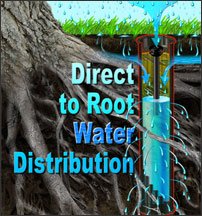Vertical Porous Cylinder Watering Channel

The rate of infiltration of water into the surface soil is responsible for the largest loss of rainwater in natural areas. Once the infiltration capacity of the soil has been reached, most of the rain will become surface runoff. The infiltration capacity of most soils allows low intensity water events to totally infiltrate, unless the soil voids become saturated or the underlying soil is much more compact than the top layer (Morel-Seytoux 1978). High intensity water events generate substantial runoff because the infiltration capacity of the upper soil layer is surpassed, even though the underlying soil might be very dry.
Water cannot enter soil faster than it is being transmitted away, so this movement rate affects the overall infiltration rate. The complete saturation or depletion of available storage capacity in the soil also affects the overall infiltration rate. The water storage capacity of soil depends on thickness, moisture content, and porosity. Many factors, i.e. texture, root development, structure, and presence of organic matter, affect the porosity of soil.*
Current best practice solution for this infiltration flow rate variable is to use slow release water events to match the infiltration rates of the soil; watering bag, drip irrigation and soaker hoses. Saturation of descending soil horizons can only be attained when the upper soil layer is saturated and the infiltration rate is equal to or less than the underlying soil infiltration rate.*
Slow release watering events parallel the absorption ability of the mulch and the underlying soil layers. The mulch layer can absorb significant amounts of water provided which will later quickly evaporate when exposed to sunlight; preventing deep absorption into the soil. Mulch is an insulator for temperature changes and should not be considered a water holding device. Therefore, large amounts of water are needed to saturate the mulch layer allowing the underlying soil to begin the saturation process. The underlying soil layers cannot begin infiltration until the upper layers are saturated and gravity pulls the water to the next soil layer below; provided the intake is slower than the infiltration rate of the soil.**
A vertical cylinder channel will introduced water below the mulch and top soil layers directly to the Root zone 18 inches deep. Removing the variable of topsoil layers infiltration rate capacity allowing zero direct runoff.
In the vertical option with controlled time and pressure, roots can be encouraged to grow at any depth that is wanted because roots will grow to the moisture. Increasing watering time doesn’t cause horizontal expansion but vertical depth expanded. This accesses more usable moisture directly to the root system while at the same time conserving time and water. Soil moisture content was calculated to be a little more than field capacity, and this is the best moisture for plant and tree growth.
Additionally, with the vertical application salt moves from the discharge point and out of profile and this prevents accumulation of salt around the root system. ***
Implementing the Rootwell root watering system, can realize significant cost savings and performance improvements; avoiding the surface soil saturation uptake, mulch absorption recharging, soil absorption, evaporative water loss or run-off and prevents salt accumulation on the root system. BioRetention reducing peak load runoff into combined sewer overflow.
The vertical cylinder to the root-zone will save time dispensing the water while providing deeper root structure for more drought tolerant trees.****
The use of the Rootwell system offers significant cost savings. The vertical transition to the soil horizons provided by the Rootwell system requires less water and time to water labor savings; it helps to reduce the storm water runoff and provides a healthy environment for tree and shrubs to survive in the urban environment.
